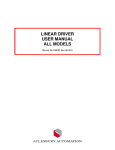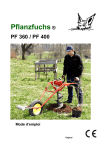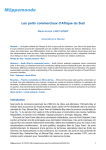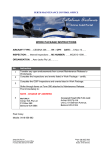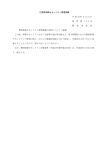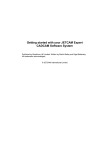Download VIBRATORY PARTS FEEDER USER MANUAL EURO SERIES
Transcript
VIBRATORY PARTS FEEDER USER MANUAL EURO SERIES Manual No 238001 Rev.09.00.A VIBRATORY PARTS FEEDER EURO SERIES INTRODUCTION Please read this manual carefully before using your Vibratory Parts Feeder. This manual contains information that will assist you with all aspects of safe unpacking, installation and maintenance, to ensure machine longevity. WARNING ‘Umax’ dial on all control boxes has been factory set to maximum coil voltage for multi-voltage coils. Any adjustment of this setting could result in damage to the coil and control box due to overheating. This manual illustrates all options that are available in the Euro Series V.P.F. range, i.e. SI 150, 200, 250, 400, 625 and 630; not all of these will be on your machine. Before reading this manual please check that the following have been supplied. • • • Drive unit Bowl Spare springs and shims (untooled equipment only) Aylesbury Automation makes every effort to ensure that this manual is reviewed whenever any significant changes are made to the design. However our policy of continuous product improvement may result in some small differences between the unit supplied and the description in this document. Risk assessments for these products are available on request. For general enquiries regarding your machine, contact the Service Department on: Tel. +44 (0) 1296 314300 Fax. +44 (0) 1296 421625 For spare parts enquiries, contact the Automation Sales Department on: Tel. +44 (0) 1296 314300 Fax. +44 (0) 1296 482424 VIBRATORY PARTS FEEDER EURO SERIES Contents Page No. Certificate of conformity/incorporation Pocket, inside front cover Technical Specification Pocket, inside front cover 1.0 INSTALLATION 1.1 Services ____________________________________________________________ 1 1.2 Unpacking and Handling _______________________________________________ 1 1.3 Setting-up Procedure __________________________________________________ 1 2.0 TUNING THE UNIT 2.1 Tuning Procedure _____________________________________________________ 3 2.2 Recommended Parts for Tuning _________________________________________ 3 3.0 COIL 3.1 Adjustment of Coil to Armature Clearance __________________________________ 4 3.2 Replacing the Voltage Plug _____________________________________________ 5 3.3 Replacing the Complete Coil ____________________________________________ 5 4.0 SPRING REPLACEMENT ________________________________________________ 8 5.0 TORQUE SETTINGS ____________________________________________________ 8 6.0 MAINTENANCE ________________________________________________________ 9 7.0 NOISE REDUCTION ____________________________________________________ 9 8.0 GUIDELINES FOR ADDING ORIENTATION TOOLING (IF NOT FACTORY FITTED) _ 9 9.0 TROUBLESHOOTING __________________________________________________ 10 10.0 RECOMMENDED SPARES _____________________________________________ 11 11.0 DECOMMISSIONING __________________________________________________ 11 Parts List – All Models Assembly Drawing - Model 150 Assembly Drawing - Model 200 Assembly Drawing - Model 250 Assembly Drawing - Model 400 Assembly Drawing - Model 625 Assembly Drawing - Model 630 VIBRATORY PARTS FEEDER EURO SERIES 1.0 INSTALLATION 1.1 Services The following services are required before the machine can be installed: 200v 50/60Hz. Single Phase or 100v 50/60Hz. Single Phase 1.2 Unpacking and Handling NOTE: The user is recommended to retain the packaging. If any damage has occurred to the equipment, Aylesbury Automation will need to inspect all materials. WARNING Do not lift the V.P.F. by the top plate or the bowl, as this WILL strain the springs and alter the coil setting. See 'Technical Description' for the weight of the parts feeder to enable it to be lifted safely into position. MODEL NUMBER HANDLING 150 Lift carefully into its operating position Remove the spare springs and shims (untooled units only), then move the v.p.f. carefully into its operating position Remove the spare springs and shims (untooled units only), then move the v.p.f. into position using the eyebolt supplied with the unit located in the centre mounting hole of the bowl. Once the unit is positioned, the eyebolt should be removed and the rotating centre or bowl plug placed into position. 200 250 & 400 625 630 Remove the spare springs and shims (untooled units only), then move the feeder into position using the three eyebolts which are attached to the base casing of the unit and can be accessed by removing the cover. Once the unit is positioned the cover should be replaced. The three eyebolts may remain fitted in the base. Remove the spare springs and shims (untooled units only), then move the feeder into position using the three eyebolts which are attached to the base casing of the unit and can be accessed by removing the rotating centre. Once the unit is positioned the rotating centre should be replaced. The three eyebolts may remain fitted in the base. WEIGHT (UNTOOLED UNIT) 8.4 Kg. 13.2 Kg. 250 – 53.2 Kg. 400 – 120.0 Kg. 260.0 Kg. 240.0 Kg. 1.3 Setting-up Procedure CAUTION: Do not connect the vibratory parts feeder directly to the mains supply. Connect the electrical supply to the control box (see control box instructions). Plug the vibratory parts feeder into the control box. Turn the control box on. Rotate the control knob until the feed rate is satisfactory, but no further than necessary, as excessive vibration may actually decrease output and cause unnecessary wear and waste of power. SAFETY WARNING Do not attempt to start the machine unless you understand what you are doing and you have taken all the safety precautions normally required for industrial electronic control systems and machines. Read thoroughly any manuals included with this machine for equipment with which you are unfamiliar. 1 VIBRATORY PARTS FEEDER EURO SERIES NOTE: This machine is to be used only with the product for which it was supplied. It is recommended that the vibratory parts feeder should be mounted on one of the specially developed stands, which provides a safe mounting base for the parts feeder. If one of these stands is used it MUST be securely bolted to a foundation before the parts feeder is attached. If an alternative stand is to be used, it must be of a stable and rigid construction so that it prevents the transmission of vibration produced by the parts feeder. The vibratory parts feeder is usually equipped with a base plate that can be secured to a suitable work surface using the holes provided. If there is no base plate supplied with the machine, the parts feeder must be secured using the threaded holes on the underside of the mounting feet. (SI 150, 200, 250 and 400 - 3 mounting feet) (SI 625 and 630 - 4 mounting feet) 2 VIBRATORY PARTS FEEDER EURO SERIES 2.0 TUNING THE UNIT SAFETY WARNING NOTE: At no time should hands or tools be placed within the bowl or any fitted tooling, nor attempts be made to clear blockages whilst the machine is operating. Bowl feeders vibrate at high frequency and contact with any of the moving surfaces could cause abrasions. ISOLATE POWER SUPPLY Vibratory Parts Feeders may require a warm up time of 30 minutes before they reach optimum feed rate. 2.1 Tuning Procedure Although the drive units are tuned during manufacture, after tooling has been fitted it may be necessary to retune your system. Correct tuning of the vibratory system is essential to ensure that the optimum performance is achieved. To tune the vibratory system, follow the procedure below: PROCEDURE TICK WHEN CHECKED Check that the control device has been connected correctly, see ‘1.3 Setting-up Procedure'. Remove the cover screws and then the cover. Tighten all spring stack bolts to the correct setting - see '5.0 TORQUE SETTINGS'. Check the air gap between the armature and the coil. If necessary adjust the gap to the correct dimension. See '3.1 Adjustment of Coil to Armature Clearance'. With the controller running, slowly loosen the bottom clamping screw on one of the spring stacks. This will produce a change in the speed of the components being conveyed inside the bowl. If the feed speed decreases - install one additional spring at a time with shims in between the mating surfaces. Springs should be fitted evenly around the unit. If the feed speed increases - remove one spring with its shims, one at a time evenly from each stack until the correct speed is obtained. If the feed rate is irregular on the periphery of the bowl then either: Remove one spring from the stack under or after the 'slow' spot in the direction of travel. Install one spring from the stack under or after the 'fast' spot in the direction of travel. Add counterbalance weights to the opposite side of the ‘slow’ spot. Note All tooled bowls are correctly balanced before leaving our factory. It is important that all counterbalance weights are of the appropriate weight and fitted correctly. 2.2 Recommended Parts for Tuning It may be necessary to balance an untooled bowl if additional tooling is fitted. The following counterbalance weights are available from Aylesbury Automation: PART No. A805170 A805200 A805400 WEIGHT 0.17 KG 0.20 KG 0.40 KG 3 VIBRATORY PARTS FEEDER EURO SERIES 3.0 COIL 3.1 Adjustment of Coil to Armature Clearance SAFETY WARNING The electrical power used in this equipment is at mains potential. Before carrying out maintenance or repair, isolate the electrical supply. If it is not feasible to isolate the power supply when carrying out functional testing or adjustments, any such maintenance must only be undertaken by technicians who are fully aware of the dangers involved and who have taken adequate safety precautions. If the gap is too small the coil will strike the armature block. Conversely, if the gap is too great when the controller is turned to the maximum output, the feeder does not produce sufficient power to move the part at the desired rate. It also results in the heating of the coil and wasted energy. To adjust the coil to the armature clearance, follow the procedure below for your machine: MODEL 150 200 250 400 630 625 PROCEDURE 1. With the power 'ON' turn the controller to the maximum setting (100%) 2. Undo the M10 full nut, located centrally at the bottom of the base, until the coil is just touching the top plate (armature) 1 3. Tighten the screw by /4 turn. This will give the correct air gap setting 1. Isolate power supply 2. Remove cover 3. Check air gap between coil and armature. Correct air gap (1.0mm) is indicated on the side of the coil. 4. Slacken 1 off M6 x 40 socket capscrew retaining armature 5. Place 1.0mm feeler gauge at each end of the armature. 6. Tighten 1 off M6 x 40 socket capscrew retaining armature 7. Refit cover 8. Switch power supply on 9. Unit is now ready for operation 1. Isolate power supply 2. Remove cover 3. Check air gap between coil and armature. Correct air gap 1.0mm for all models, except 400-1 and 630-1(half wave) which is 2.0mm, is indicated on the side of the coil. 4. Slacken 2 off M6 x 35 socket capscrews retaining armature 5. Place 1.0mm, 2.0mm for 400-1 and 630-1 (half wave), feeler gauge at each end of the armature. 6. Tighten 2 off M6 x 35 socket capscrews retaining armature 7. Refit cover 8. Switch power supply on 9. Unit is now ready for operation 1. Remove the cover. 2. Slacken 4 off M12 nuts retaining the coil (above coil plate) 3. Raise each corner of the coil ¼ turn in sequence until the coil and armature resonate. 4. Lower each corner of the coil ¼ turn in sequence, if necessary, until the resonance stops. 5. Refit cover 6. Unit is now ready for operation 4 NOTE The unit may be laid on its side but not completely inverted. The coil should remain fixed with the adjustments being made to the armature only VIBRATORY PARTS FEEDER EURO SERIES 3.2 Replacing the Voltage Plug The coil fitted to your vibratory parts feeder is an epoxy-encapsulated multi-voltage unit and can be adapted to different voltages and/or frequencies by following the procedure below: MODEL 200 250 400 630 PROCEDURE 1. Isolate power supply 2. Remove cover 3. Remove 2 off M2.5 x 6 cross head screws retaining the voltage plug 4. Remove the voltage plug. It may be possible that some resistance is met when attempting to remove the voltage plug. In this event, use a suitable tool to grip the plug, but not with bare jaws or using excessive force as damage will occur to the plug. 5. Insert the replacement voltage plug ensuring that the screw holes in the plug are in line with the holes in the plug housing. If the plug does not push home with only light pressure, DO NOT FORCE IT ANY FURTHER. The plug can only be inserted in one orientation. Turn plug round and reinsert. 6. Reinsert 2 off M2.5 x 6 crosshead screws. Do not use excessive force when tightening these screws, as this will strip the thread of the voltage plug housing. 7. Refit cover 8. Switch power supply on 9. Unit is now ready for operation NOTE Always isolate power supply before attempting to replace any voltage plugs For full range of available plugs refer to the table below: Part Number A803173 A803174 A803175 A803176 Voltage 200v 200v 100v 100v Frequency 100 Hz (full wave) 50 Hz (half wave) 100 Hz (full wave) 50 Hz (half wave) 3.3 Replacing the Complete Coil NOTE: It is strongly recommended that an Aylesbury Automation service engineer carry out coil replacement. Should customers wish to effect this work themselves the instructions in this Section should be strictly adhered to. SAFETY WARNING Before carrying out coil replacement, ISOLATE POWER SUPPLY. 5 VIBRATORY PARTS FEEDER EURO SERIES Note: Model 150, 200, 250 (open centre bowls only), 400 and 630 coils can be removed with bowl in place. The lower socket capscrew retaining the spring banks to the base machining on Models 250, 400 and 630 may vary depending on the number of springs fitted to the unit. MODEL 1. 2. 3. 4. 5. 150 6. 7. 8. 9. 10. 11. 12. 13. 1. 2. 3. 4. 5. 200 6. 7. 8. 9. 10. 11. 12. 13. 1. 2. 3. 4. 250 5. 6. 7. 8. 9. 10. 11. PROCEDURE Isolate power supply Remove cover Disconnect plug from control box. Remove plug from cable Remove cable clamp Remove 3 off lower M6 x 20 socket capscrews retaining spring bank to base machining, but do not extract completely from spring bank, as this retains spring spacers. Remove top plate complete with spring banks and bowl (if fitted) Invert unit and remove M10 full nut and washer, located on underside of base, retaining coil Turn unit back to original position and extract coil, pulling electrical cable through base plate To replace coil, repeat steps 3-7 in reverse order Tighten 3 off M6 x 20 socket capscrews retaining top plate to required settings (see ‘5.0 TORQUE SETTINGS’). Set coil to armature air gap (see ‘3.1 Adjustment of Coil to Armature Clearance’). Refit cover Switch power supply on Unit is now ready for operation Isolate power supply Remove cover Disconnect plug from control box. Remove plug from cable Remove 3 off lower M8 x 35 socket capscrews retaining spring banks to base casting, but do not extract completely from spring bank, as this retains spring spacers. Remove top plate complete with spring banks and bowl (if fitted) Invert unit and remove 3 off M6 x 20 socket capscrews and M6 washers retaining base plate. Remove base plate Remove 2 off M6 x 40 socket capscrews and M6 washers retaining coil. Turn unit back to original position, undo cable gland and extract coil, pulling electrical cable through base unit To replace coil, repeat steps 3-7 in reverse order Tighten 3 off M8 x 35 socket capscrews retaining top plate to required settings (see ‘5.0 TORQUE SETTINGS’). Set coil to armature air gap (see ‘3.1 Adjustment of Coil to Armature Clearance’). Refit cover Switch power supply on Unit is now ready for operation Isolate power supply Remove cover Remove 3 off lower M12 x 40 socket capscrews retaining spring banks to base casting, but do not extract completely from spring bank, as this retains spring spacers. Remove top plate complete with spring banks and bowl (if fitted) Remove all cable ties and remove terminal block cover and slacken off 3 terminals; live, neutral and earth. Remove 2 off M6 x 35 socket capscrews retaining faulty coil and trace cable back to terminal block To replace coil, repeat steps 3-6 in reverse order Tighten 3 off M12 x 40 socket capscrews retaining top plate to required settings (see ‘5.0 TORQUE SETTINGS’). Set coil to armature air gap (see ‘3.1 Adjustment of Coil to Armature Clearance’). Refit cover Switch power supply on Unit is now ready for operation 6 VIBRATORY PARTS FEEDER EURO SERIES MODEL 400 625 630 PROCEDURE 1. Isolate power supply 2. Remove cover 3. Remove 3 off lower M12 x 60 socket capscrews retaining spring banks to base casting, but do not extract completely from spring bank, as this retains spring spacers. Remove top plate complete with spring banks and bowl (if fitted) 4. Remove all cable ties and remove terminal block cover and slacken off 3 terminals; live, neutral and earth. 5. Remove 2 off M6 x 45 socket capscrews retaining faulty coil and trace cable back to terminal block 6. To replace coil, repeat steps 3-5 in reverse order 7. Tighten 3 off M12 x 60 socket capscrews retaining top plate to required settings (see ‘5.0 TORQUE SETTINGS’). 8. Set coil to armature air gap (see ‘3.1 Adjustment of Coil to Armature Clearance’). 9. Refit cover 10. Switch power supply on 11. Unit is now ready for operation 1. Isolate power supply 2. Remove cover 3. Remove bowl 4. Remove 6 off upper M12 x 60 socket capscrews retaining spring banks to bowl plate. Remove bowl plate. Note: this must be performed by 2 people 5. Remove 4 off M12 full nuts retaining coil to studding 6. Disconnect coil cable from terminal block and lift coil clear of studding 7. To replace coil, repeat steps 3-6 in reverse order 8. Tighten 6 off M12 x 60 socket capscrews retaining bowl plate to required settings (see ‘5.0 TORQUE SETTINGS’). 9. Set coil to armature air gap (see ‘3.1 Adjustment of Coil to Armature Clearance’). 10. Refit cover 11. Switch power supply on 12. Unit is now ready for operation 1. Isolate power supply 2. Remove cover 3. Remove 4 off lower M12 x 60 socket capscrews retaining spring banks to base casting, but do not extract completely from spring bank, as this retains spring spacers. Remove top plate complete with spring banks and bowl (if fitted). Note: this must be performed by 2 people 4. Remove all cable ties and remove terminal block cover and slacken off 3 terminals; live, neutral and earth. 5. Remove 2 off M6 x 45 socket capscrews retaining faulty coil and trace cable back to terminal block 6. To replace coil, repeat steps 3-5 in reverse order 7. Tighten 4 off M12 x 60 socket capscrews retaining top plate to required settings (see ‘5.0 TORQUE SETTINGS’). 8. Set coil to armature air gap (see ‘3.1 Adjustment of Coil to Armature Clearance’). 9. Refit cover 10. Switch power supply on 11. Unit is now ready for operation 7 VIBRATORY PARTS FEEDER EURO SERIES 4.0 SPRING REPLACEMENT The springs have standard dimensions and require no adjustment after making a replacement. MODEL ALL PROCEDURE 1. Isolate power supply 2. Remove cover 3. Having identified the spring bank which houses the broken spring (see ‘2.1 Tuning Procedure’ and ‘9.0 TROUBLESHOOTING’) remove socket capscrews retaining the identified spring bank, making note of the position and thickness of the springs being removed 4. Replace broken spring/springs and reassemble spring bank 5. Refit spring bank and insert socket capscrews top and bottom 6. Release and re-tighten all the other spring fixings. Tighten each fixing gradually (as you would a car wheel) to reduce the strain imparted to the springs (see ‘5.0 TORQUE SETTINGS’). 7. Set coil to armature air gap (see ‘3.1 Adjustment of Coil to Armature Clearance’). 8. Switch power supply on 9. Unit is now ready for operation 5.0 TORQUE SETTINGS The table below lists the torque settings for all socket capscrews requiring tightening when normal service procedures are carried out. Under no circumstances must the settings listed be exceeded. COMPONENT Top plate Bottom plate Coil Armature TORQUE lbf.ft Nm. lbf.ft Nm. lbf.ft Nm. lbf.ft Nm. SI 150 7.1 9.5 7.1 9.5 N/A N/A N/A N/A SI 200 21.5 29 29 39 12 16 9 12 SI 250 74 100 100 135 12 16 9 12 SI 400 74 100 100 135 12 16 9 12 SI 625 100 135 57 77 N/A N/A N/A N/A SI 630 74 100 100 135 12 16 9 12 TO ENSURE THAT THE UNIT OPERATES AT ITS OPTIMUM EFFICIENCY, AND TO PREVENT ANY DAMAGE TO THE UNIT DUE TO EXCESSIVE TORQUE, THE ABOVE SETTINGS SHOULD BE ADHERED TO USING A TORQUE WRENCH. 8 VIBRATORY PARTS FEEDER EURO SERIES 6.0 MAINTENANCE WARNING By virtue of design the parts feeder will produce vibratory residue from the products being fed. It is the responsibility of the operating company to ensure that all relevant safety precautions are taken to handle any hazardous material at all times during operation, cleaning and maintenance. Daily 1. Wipe clean the bowl and the bowl tooling taking care to avoid the possibility of personal injury from any sharp edges or projections. 2. Check the performance and look for dead spots as an indication of any broken springs (see ‘9.0 TROUBLESHOOTING'). 3. Inspect and clean any air jets, where applicable. Weekly 1. SAFETY CHECKS. Check that any safety or emergency devices where fitted are fully functional. 2. Inspect the feeder tooling for any wear and replace where necessary. 3 Monthly 1. Check the torque of all spring bolts (See '5.0 TORQUE SETTINGS'). 2. Check the tightness of all the rubber feet and tighten if required. 7.0 NOISE REDUCTION Whilst every attempt has been made by using the most appropriate materials and bowl feeder coatings etc due to the nature of vibratory feeders some components may generate unacceptable noise levels. In this instance to reduce the noise emission from the components in the bowl an optional acoustic enclosure can be fitted, this reduces the noise level by approximately 10dB (A), which can be increased further by the addition of an internal lining. This noise reduction does depend, however entirely on the products being fed, the feed rate and the bowl construction. The acoustic enclosures are manufactured in a sound absorbing material, incorporating a clear removable lid that is split to allow easy refill of the bowl. A range of sizes is available to accommodate tooling. 8.0 GUIDELINES FOR ADDING ORIENTATION TOOLING (IF NOT FACTORY FITTED) If you wish to add orientation tooling to an untooled bowl, please read the following guidelines: • • • • • All tooling fitted to the vibratory parts feeder should be of a light but rigid construction. The tooling must be securely fixed to the bowl to achieve the maximum performance. Discharge tooling beyond the normal bowl outlet position should be kept to a minimum and NOT project beyond the greatest diameter of the bowl. Support brackets for the tracking and tracks should be fitted to the base plate or stand and NEVER to the vibratory system, as such additions will create malfunctions with feeding, and may damage the power unit and decrease the feed rate. ALWAYS maintain a gap of approximately 1.5mm between the bowl discharge and the track, contact between these when the parts feeder is running MUST be avoided. 9 VIBRATORY PARTS FEEDER EURO SERIES 9.0 TROUBLESHOOTING Below is a guide to help solve some of the problems that might occur during the life of the machine. If after following all the instructions carefully you still have a problem, then do not hesitate to telephone our Service Department for assistance. SAFETY WARNING Symptom Parts feeder not running After a period of time the system is not giving the required output. Parts feeder develops loud noise. Feeder characteristics change. Erratic feeding and dead spots. Before any maintenance is carried out ISOLATE POWER SUPPLY Possible Cause/Remedy Check electrical supply to control box. Check connections from control box to feeder. Fuse in control box failed - change fuse. Screws on spring stacks loose - tighten to the correct value (see '5.0 TORQUE SETTINGS’). Fixing screws for the bowl loose – tighten Coil gap or gaps incorrect – adjust (see ‘3.1 Adjustment of Coil to Armature Clearance’). Springs broken – replace (see ‘4.0 SPRING REPLACEMENT’). Bowl tooling is loose – Tighten all tooling fixtures Rubber foot is loose - tighten. Metal cover is loose - tighten screws. Rotating centre jammed – eliminate jamming. Foreign bodies in coil gap - clean then check the gap, adjust if necessary (see ‘3.1 Adjustment of Coil to Armature Clearance’). Coil gap or gaps incorrect – adjust (see ‘3.1 Adjustment of Coil to Armature Clearance’). Bowl tooling is loose – Tighten all tooling fixtures Check tuning and control box settings. Too many components in bowl (overloading) – remove some product. Check that the bowl is fixed to the drive unit. Check for broken springs. If, after changing the position of the bowl on the unit, the dead area moves to a new position in the bowl, then it would be reasonable to expect one or more broken springs (see '4.0 SPRING REPLACEMENT’ and '2.1 Tuning Procedure’). Check for broken welds. This can be determined by relocating the bowl 120° on the unit. If the feeding problems remain at the same point in the bowl, it can be assumed to be within the bowl structure. Bowl tooling is loose – Tighten all tooling fixtures 10 Tick When Checked VIBRATORY PARTS FEEDER EURO SERIES 10.0 RECOMMENDED SPARES It is essential for the continuing safe and efficient operation of your machine that only genuine replacement parts are used. These are made to original drawings and manufacturing tolerances and are, therefore, completely interchangeable with the originals. Orders or enquiries about machine parts should be directed to the Sales Department, quoting the machine reference number (clearly stamped on the machine identification plate), and the part number. In this way reference can be immediately made to the details and drawings of the machine. Spares of certain items should be kept in stock by the customer to ensure immediate availability, this particularly applies to those items which are susceptible to wear or abuse, these are marked with # on the parts list page. NOTES: Orientation tooling is not normally supplied as a spare. When required a service engineer can be contacted to manufacture and replace on site, or the bowl and drive should be returned for the work to be carried out by the manufacturer. THE BOWL COATING IS CLASSED AS A CONSUMABLE ITEM, AND AS SUCH, GENERAL WEAR AND TEAR IS NOT COVERED UNDER THE NORMAL WARRANTY. 11.0 DECOMMISSIONING WARNING: By virtue of design, any dynamic parts movement system may produce component contact residue from the products being fed. It is the responsibility of the operating company to ensure that all relevant safety precautions are taken should any hazardous materials be present during cleaning and maintenance. To decommission the vibratory parts feeder at the end of a run, follow the procedure below: 1. 2. 3. 4. Run the vibratory parts feeder until it is clear of components. Clean the vibratory parts feeder thoroughly. Disconnect the main power supply unit. Lightly oil all non-painted surfaces 11 Item No. 1 2 3 4 5 6 7 8 9 10 11 12 13 14 15 16 17 18 19 20 21 22 23 24 25 26 27 28 29 30 31 32 33 34 35 36 37 38 39 40 41 42 43 44 45 46 47 48 Note: Description Bottom Casting (clock) Bottom Casting (c’clock) Top Plate Sub-Assy. (clock) Top Plate Sub-Assy. (c’clock) Base Mounting Plate Cover Centre Spindle Eye Bolt Rubber Foot Rubber Ring Rubber Edging Strip Clamp Plate End Plate Shim Spring Separator Spring Block Spring Block Clamp Spring – 1.0mm Thick Spring – 1.5mm Thick Spring – 2.0mm Thick Spring – 2.5mm Thick Spring – 9.5mm Thick Spring – 12.7mm Thick Multi-voltage/frequency Coil 110v Coil 230v Coil 100v Coil 200v Coil Voltage plug 100v Half Wave Voltage plug 100v Full Wave Voltage plug 200v Half Wave Voltage plug 200v Full Wave Armature Cable Clamp M5 x 10 Socket Capscrew M5 x 16 Socket Capscrew M6 x 10 Socket Capscrew M6 x 20 Socket Capscrew M6 x 35 Socket Capscrew M6 x 45 Socket Capscrew M6 x 50 Socket Capscrew M8 x 25 Socket Capscrew M8 x 35 Socket Capscrew M10 x 50 Socket Capscrew M12 x 40 Socket Capscrew M12 x 50 Socket Capscrew M12 x 60 Socket Capscrew M12 x 80 Socket Capscrew M6 x 16 C’sunk Socket Screw M8 x 20 C’sunk Socket Screw M10 x 20 C’sunk Socket Screw M10 x 25 C’sunk Socket Screw M12 x 40 Hex. Head Screw Self-Tapping Screw M8 Nyloc Nut M10 Fullnut M12 Fullnut M6 Washer M12 Washer M10 Spring Washer M5 x 26 Spring Pin M12 x 150 Stud SI150 A251011 A251012 A251001 A251002 A251019 A251024 A251018 A200712 Z56996 A200673 #A20067 #A251005 DRIVE UNIT MODEL NUMBER SI250 SI400 A290286 A290436 A290287 A290437 A294021 A294121 A294020 A294120 A290289 A290439 A290308 A290477 A290276 A290426 A803106 A803017 A290230 A290274 A290425 SI200 A290023 A290022 A290021 A290020 A290229 A290236 A290233 A290232 #A290240 A290271 A290270 #A290278 A290271 A290270 #A290278 #A290235 #A290234 #A251006 A253006 A253005 A290669 A290701 SI630 A290666 A290667 A290680 A290681 A290669 A290654 A803107 A290425 A803107 A290425 #A200569 A258004 #A200570 #A200876 A257010 A200878 A290271 A290270 #A290278 ℜ #ℑ #A290272 #A290273 #A290420 #A290651 #A200879 #A258001 #A803099 #A803097 #A803098 #A803084 #A803081 #A803176 #A803175 #A803174 #A803173 #ℵ #A803098 #A203263 #A203262 #A257031 #A257030 #ℵ #A803176 #A803175 #A803174 #A803173 A201359 A801186 A801709 A801167 A801709 A801690 #A801899 A801960 A801899 A801899 A801899 A801901 A801901 A801923 A801695 A801682 #A801954 #A801947 #A801820 #A801831 #A801831 #A801907 #A801827 #A801827 #A801907 #A801907 A801767 A801997 A801767 A801725 A801694 A801903 A801766 A801672 A801766 A801766 A801769 A290711 A290710 A801769 A290711 A290710 A801766 A801700 A290711 A801711 A801718 A801238 Solid centre bowls for Models 250, 400 and 630 require a centre plug part no. A290670 ℵ Model 400/630 coils supplied as 200v 50Hz ½ wave (A803086) or full wave (A803082) ℑ Springs for Model SI400: 400/1 2.0mm thick - A290420, 2.5mm thick – A290651 400/2 2.0mm thick - A290272, 2.5mm thick – A290273 ℜ Centre spindles for Model SI630: SI625 A290702 Solid centre bowls – A290685 Open centre bowls – A290689 A801821 A801769 A290711 A290710















![Powermate P-RTT-196MD-[E] Parts list](http://vs1.manualzilla.com/store/data/006990491_1-51a541149ce83286c792c512ef782a2f-150x150.png)
